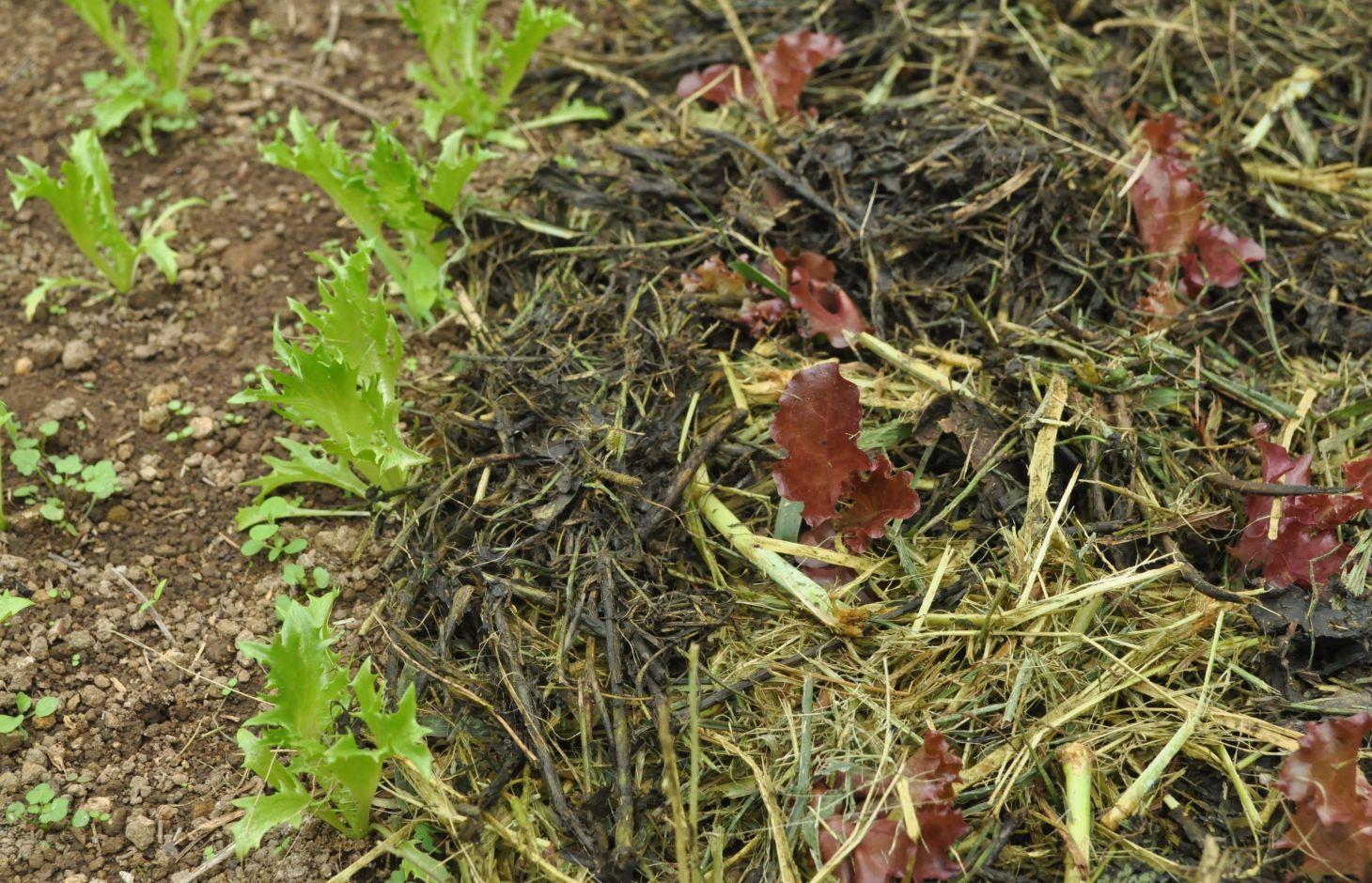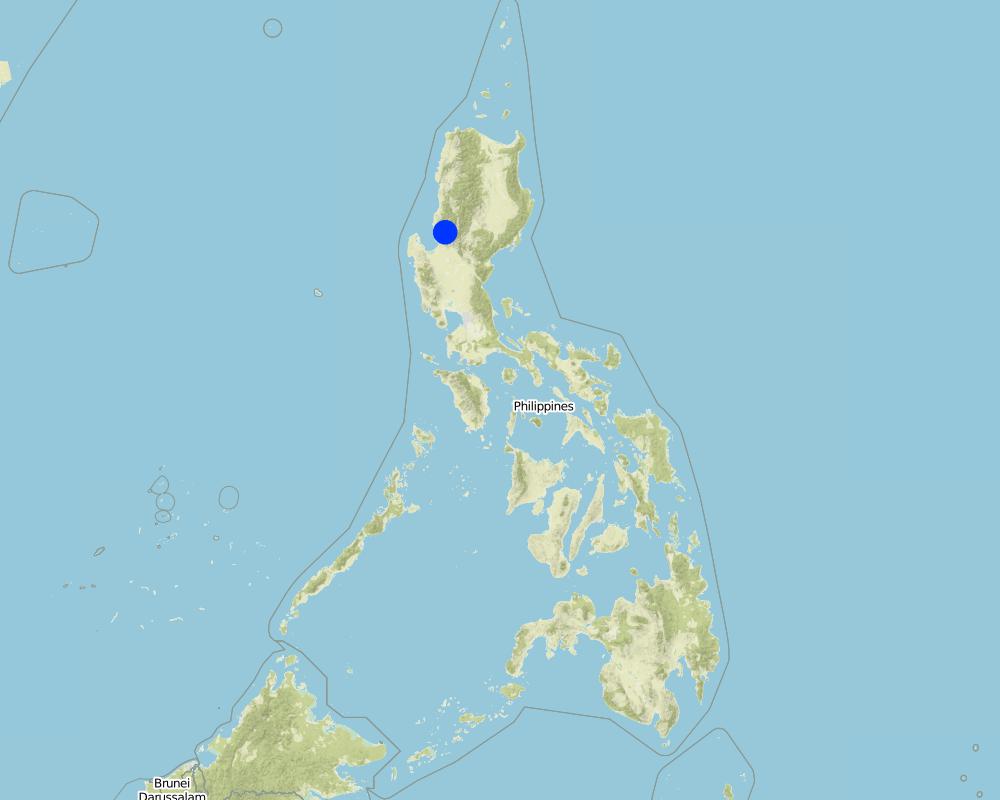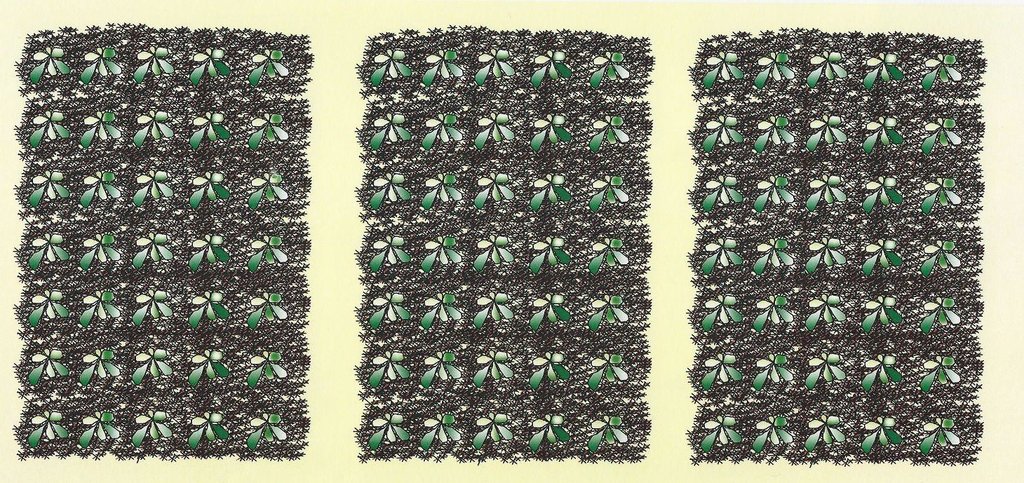Organic Mulching [Philippines]
- Creation:
- Update:
- Compiler: Philippine Overview of Conservation Approaches and Technologies
- Editor: –
- Reviewers: Fabian Ottiger, Alexandra Gavilano
technologies_1303 - Philippines
View sections
Expand all Collapse all1. General information
1.2 Contact details of resource persons and institutions involved in the assessment and documentation of the Technology
Key resource person(s)
land user:
Acosta Ambrocio
The Master's Garden
Philippines
Name of the institution(s) which facilitated the documentation/ evaluation of the Technology (if relevant)
Bureau of Soils and Water Management (Bureau of Soils and Water Management) - PhilippinesName of the institution(s) which facilitated the documentation/ evaluation of the Technology (if relevant)
The Master's Garden - Philippines1.3 Conditions regarding the use of data documented through WOCAT
The compiler and key resource person(s) accept the conditions regarding the use of data documented through WOCAT:
Yes
2. Description of the SLM Technology
2.1 Short description of the Technology
Definition of the Technology:
Organic mulching is a practice of applying thin layer of organic materials on the soil surface that decompose over time for the purpose of conserving soil moisture, reducing soil erosion, improving soil fertility, and reducing weed growth.
2.2 Detailed description of the Technology
Description:
It is a farm residue management technique of utilizing organic materials, such as locally available grasses and weeds, into useful purposes. These grasses and weeds are cut or chop into smaller sizes then applied and spread in layers over the ground or soil surface. It will then be served as cover to the soil.
Purpose of the Technology: The purposes of this technology are the following: to conserve soil moisture; to reduce soil erosion; to improve soil fertility; and to reduce weed growth.
Establishment / maintenance activities and inputs: In practicing this type of mulching, these are the following steps and activities: (1) Hauling of grass and weeds available in the farm; (2) Shredding of grass and weeds using the shredder; (3) Spraying of Indigenous microorganism (IMO) solution to the shredded grass and weeds; and (4) Spreading of the shredded materials (about 1 inch thick) in the vegetable beds after transplanting the crops.
Natural / human environment: Master’s Garden of Mr. Ambrocio Acosta is located at Barangay Puguis, La Trinidad, Benguet. The province is Type I climate under the Coronas system of classification with distinct wet and dry seasons with an average annual rainfall of 3,879 mm. The dry season is from November to April while the wet season is from May to October. The farm has an elevation of 1,342 meters above sea level with less than 40% slope. The farm was manually terraced with UV treated plastic shed. The production system is manually managed and cultivated by Mr. Acosta and his two farm laborers.
2.3 Photos of the Technology
2.5 Country/ region/ locations where the Technology has been applied and which are covered by this assessment
Country:
Philippines
Region/ State/ Province:
La Trinidad, Benguet
Specify the spread of the Technology:
- evenly spread over an area
If precise area is not known, indicate approximate area covered:
- < 0.1 km2 (10 ha)
Map
×2.6 Date of implementation
If precise year is not known, indicate approximate date:
- 10-50 years ago
2.7 Introduction of the Technology
Specify how the Technology was introduced:
- through land users' innovation
- during experiments/ research
3. Classification of the SLM Technology
3.2 Current land use type(s) where the Technology is applied

Cropland
- Annual cropping
- Perennial (non-woody) cropping
Annual cropping - Specify crops:
- medicinal/ aromatic/ pesticidal plants and herbs
- root/tuber crops - sugar beet
- vegetables - leafy vegetables (salads, cabbage, spinach, other)
- tomatoes, cucumbers
Perennial (non-woody) cropping - Specify crops:
- medicinal, aromatic, pesticidal plants - perennial
Number of growing seasons per year:
- 2
Comments:
Major cash crop annual cropping: Lettuce, tomatoes, cucumber, sugar beets, salad pe
Major cash crop perennial cropping: Thyme, mint, tarragon and chives
Major food crops: Lettuce and tomato
Major land use problems (compiler’s opinion): soil fertility, soil erosion
Major land use problems (land users’ perception): vulnerable to soil erosion, soil fertility
Future (final) land use (after implementation of SLM Technology): Cropland: Ca: Annual cropping
3.3 Has land use changed due to the implementation of the Technology?
Has land use changed due to the implementation of the Technology?
- Yes (Please fill out the questions below with regard to the land use before implementation of the Technology)

Grazing land
- Extensive grazing
3.4 Water supply
Water supply for the land on which the Technology is applied:
- full irrigation
3.5 SLM group to which the Technology belongs
- improved ground/ vegetation cover
3.6 SLM measures comprising the Technology

agronomic measures
- A1: Vegetation/ soil cover
- A2: Organic matter/ soil fertility
- A3: Soil surface treatment
Comments:
Main measures: agronomic measures
Type of agronomic measures: mulching
3.7 Main types of land degradation addressed by the Technology

soil erosion by water
- Wt: loss of topsoil/ surface erosion

biological degradation
- Bc: reduction of vegetation cover
- Bl: loss of soil life

water degradation
- Ha: aridification
Comments:
Main type of degradation addressed: Ha: aridification
Secondary types of degradation addressed: Wt: loss of topsoil / surface erosion, Bc: reduction of vegetation cover, Bl: loss of soil life
Main causes of degradation: other natural causes (avalanches, volcanic eruptions, mud flows, highly susceptible natural resources, extreme topography, etc.) specify (extreme topography)
Secondary causes of degradation: Heavy / extreme rainfall (intensity/amounts)
3.8 Prevention, reduction, or restoration of land degradation
Specify the goal of the Technology with regard to land degradation:
- prevent land degradation
- reduce land degradation
Comments:
Main goals: prevention of land degradation
Secondary goals: mitigation / reduction of land degradation
4. Technical specifications, implementation activities, inputs, and costs
4.1 Technical drawing of the Technology
Technical specifications (related to technical drawing):
Vegetables covered with shredded weeds and grasses.
Technical knowledge required for field staff / advisors: low
Technical knowledge required for land users: low
Main technical functions: control of raindrop splash, improvement of ground cover, increase in organic matter, increase / maintain water stored in soil
Secondary technical functions: control of dispersed runoff: retain / trap, improvement of topsoil structure (compaction), increase in nutrient availability (supply, recycling,…)
Mulching
Material/ species: Grass and weeds available in the farm (Ageratum houstonianum, Dentella repens, Setaria palmifolia, I
Quantity/ density: 875kg
Remarks: shredded and applied on the soil surface
Author:
Patricio A. Yambot, Bureau of Soils and Water Management
4.2 General information regarding the calculation of inputs and costs
other/ national currency (specify):
Philippine pesos
If relevant, indicate exchange rate from USD to local currency (e.g. 1 USD = 79.9 Brazilian Real): 1 USD =:
45.0
Indicate average wage cost of hired labour per day:
5.56
4.3 Establishment activities
| Activity | Timing (season) | |
|---|---|---|
| 1. | Buying a shredder | |
| 2. | buying a sprayer |
4.4 Costs and inputs needed for establishment
| Specify input | Unit | Quantity | Costs per Unit | Total costs per input | % of costs borne by land users | |
|---|---|---|---|---|---|---|
| Equipment | Shredder | ha | 1.0 | 2222.22 | 2222.22 | 100.0 |
| Equipment | Sprayer | ha | 1.0 | 22.22 | 22.22 | 100.0 |
| Total costs for establishment of the Technology | 2244.44 | |||||
| Total costs for establishment of the Technology in USD | 49.88 | |||||
Comments:
Lifespan of the shredder is more than 15 years
4.5 Maintenance/ recurrent activities
| Activity | Timing/ frequency | |
|---|---|---|
| 1. | Hauling of grasses and weeds available in the farm | |
| 2. | Shredding of grasses and weeds | |
| 3. | Spraying of IMO to the shredded grasses and weeds | |
| 4. | Spreading of shredded grasses and weeds to the soil surface |
4.6 Costs and inputs needed for maintenance/ recurrent activities (per year)
| Specify input | Unit | Quantity | Costs per Unit | Total costs per input | % of costs borne by land users | |
|---|---|---|---|---|---|---|
| Labour | Labour | ha | 1.0 | 61.12 | 61.12 | 100.0 |
| Total costs for maintenance of the Technology | 61.12 | |||||
| Total costs for maintenance of the Technology in USD | 1.36 | |||||
Comments:
Machinery/ tools: shredder
4.7 Most important factors affecting the costs
Describe the most determinate factors affecting the costs:
purchase of shredding machine
5. Natural and human environment
5.1 Climate
Annual rainfall
- < 250 mm
- 251-500 mm
- 501-750 mm
- 751-1,000 mm
- 1,001-1,500 mm
- 1,501-2,000 mm
- 2,001-3,000 mm
- 3,001-4,000 mm
- > 4,000 mm
Agro-climatic zone
- humid
Thermal climate class: tropics
5.2 Topography
Slopes on average:
- flat (0-2%)
- gentle (3-5%)
- moderate (6-10%)
- rolling (11-15%)
- hilly (16-30%)
- steep (31-60%)
- very steep (>60%)
Landforms:
- plateau/plains
- ridges
- mountain slopes
- hill slopes
- footslopes
- valley floors
Altitudinal zone:
- 0-100 m a.s.l.
- 101-500 m a.s.l.
- 501-1,000 m a.s.l.
- 1,001-1,500 m a.s.l.
- 1,501-2,000 m a.s.l.
- 2,001-2,500 m a.s.l.
- 2,501-3,000 m a.s.l.
- 3,001-4,000 m a.s.l.
- > 4,000 m a.s.l.
Comments and further specifications on topography:
Slopes on average: Steep (31-60&) (Average slope is 40%)
5.3 Soils
Soil depth on average:
- very shallow (0-20 cm)
- shallow (21-50 cm)
- moderately deep (51-80 cm)
- deep (81-120 cm)
- very deep (> 120 cm)
Soil texture (topsoil):
- medium (loamy, silty)
Topsoil organic matter:
- medium (1-3%)
If available, attach full soil description or specify the available information, e.g. soil type, soil PH/ acidity, Cation Exchange Capacity, nitrogen, salinity etc.
Soil fertility is medium
Soil drainage/infiltration is medium
Soil water storage is low
5.4 Water availability and quality
Ground water table:
5-50 m
Availability of surface water:
good
Water quality (untreated):
for agricultural use only (irrigation)
5.5 Biodiversity
Species diversity:
- high
5.6 Characteristics of land users applying the Technology
Market orientation of production system:
- mixed (subsistence/ commercial)
Off-farm income:
- less than 10% of all income
Relative level of wealth:
- average
Individuals or groups:
- individual/ household
Level of mechanization:
- manual work
Gender:
- men
Indicate other relevant characteristics of the land users:
Land users applying the Technology are mainly common / average land users
Population density: 10-50 persons/km2
Annual population growth: 3% - 4%
100% of the land users are average wealthy and own 100% of the land.
Level of mechanization: Vegetables and herbs were planted at beds which were cultivated manually.
Market orientation: mixed (subsistence and commercial) (Harvested vegetables and herbs were for the subsistence of his family and were sold commercially at leading groceries and supermarket through a private marketing corporation known as KIAS Organic Gree)
5.7 Average area of land used by land users applying the Technology
- < 0.5 ha
- 0.5-1 ha
- 1-2 ha
- 2-5 ha
- 5-15 ha
- 15-50 ha
- 50-100 ha
- 100-500 ha
- 500-1,000 ha
- 1,000-10,000 ha
- > 10,000 ha
Is this considered small-, medium- or large-scale (referring to local context)?
- medium-scale
5.8 Land ownership, land use rights, and water use rights
Land ownership:
- individual, titled
Land use rights:
- individual
5.9 Access to services and infrastructure
health:
- poor
- moderate
- good
education:
- poor
- moderate
- good
technical assistance:
- poor
- moderate
- good
employment (e.g. off-farm):
- poor
- moderate
- good
markets:
- poor
- moderate
- good
energy:
- poor
- moderate
- good
roads and transport:
- poor
- moderate
- good
drinking water and sanitation:
- poor
- moderate
- good
financial services:
- poor
- moderate
- good
6. Impacts and concluding statements
6.1 On-site impacts the Technology has shown
Socio-economic impacts
Production
crop production
Comments/ specify:
Increase in yield was observed as response to all benefits brought by mulch especially as a source of N and P on the soil
land management
Comments/ specify:
Organic mulching lessen the frequency of irrigation, weed control and application of fertilizer
Water availability and quality
demand for irrigation water
Comments/ specify:
Mulch conserve the soil moisture which lessen the need for irrigation
Income and costs
expenses on agricultural inputs
Comments/ specify:
Grass and weeds are free and readily available in the environment thus reducing the expenses
farm income
workload
Comments/ specify:
Mulch conserve soil moisture, prevent weed growth and contribute nutrient to soil thus lessen the frequency of irrigation, weed control and application of fertilizer
Socio-cultural impacts
health situation
Comments/ specify:
Organic mulching eliminates the use of chemical herbicide and fertilizer thus preventing health risk for the laborers and land user.
recreational opportunities
Comments/ specify:
Farming became less laborious resulting for available time to engage to other recreational activities
SLM/ land degradation knowledge
Comments/ specify:
With the benefits gain by the application of mulch, awareness on the importance of conservation technologies increased.
conflict mitigation
Improved livelihoods and human well-being
Comments/ specify:
Organic mulching prevents risks of the farmers from exposure to harmful effects of chemical fertilizer and herbicides. It also protects the consumer on the adverse effects of chemicals on the farm produce. Furthermore, it increased awareness and market demands including premium price for organic crops making the Organic Farming an impressive source of livelihood and business.
Ecological impacts
Water cycle/ runoff
surface runoff
Comments/ specify:
Mulching prevent surface runoff by providing soil cover
evaporation
Comments/ specify:
Mulches reduced soil water evaporation by modifying or keeping the soil temperature constant
Soil
soil moisture
Comments/ specify:
Mulches reduced soil water evaporation thus retaining soil moisture
soil cover
Comments/ specify:
Even application of shredded grass and weeds as mulch also serve as soil cover
soil loss
soil compaction
Biodiversity: vegetation, animals
biomass/ above ground C
6.3 Exposure and sensitivity of the Technology to gradual climate change and climate-related extremes/ disasters (as perceived by land users)
Gradual climate change
Gradual climate change
| Season | increase or decrease | How does the Technology cope with it? | |
|---|---|---|---|
| annual temperature | increase | well |
Climate-related extremes (disasters)
Meteorological disasters
| How does the Technology cope with it? | |
|---|---|
| local rainstorm | well |
| local windstorm | not well |
Climatological disasters
| How does the Technology cope with it? | |
|---|---|
| drought | well |
Hydrological disasters
| How does the Technology cope with it? | |
|---|---|
| general (river) flood | well |
Other climate-related consequences
Other climate-related consequences
| How does the Technology cope with it? | |
|---|---|
| reduced growing period | well |
6.4 Cost-benefit analysis
How do the benefits compare with the establishment costs (from land users’ perspective)?
Short-term returns:
positive
Long-term returns:
very positive
How do the benefits compare with the maintenance/ recurrent costs (from land users' perspective)?
Short-term returns:
very positive
Long-term returns:
very positive
6.5 Adoption of the Technology
Of all those who have adopted the Technology, how many did so spontaneously, i.e. without receiving any material incentives/ payments?
- 91-100%
Comments:
100% of land user families have adopted the Technology without any external material support
1 land user families have adopted the Technology without any external material support
Comments on spontaneous adoption: Voluntary adoption of the technology was been observed since the land owner, Mr. Ambrosio Acosta, was a member and a previous officer of a small group of organic farmers, the La Trinidad Organic Producers (Latop) and was also an accredited resource speaker /trainer for Organic Agriculture-related events/forum.
There is a moderate trend towards spontaneous adoption of the Technology
6.7 Strengths/ advantages/ opportunities of the Technology
| Strengths/ advantages/ opportunities in the land user’s view |
|---|
| Organic mulch conserves soil moisture therefore reduces the need for frequent irrigation. |
| Prevent soil erosion by protecting the soil surface. |
| Organic mulch contributes nutrients and organic matter to the soil when decomposed. |
| Organic mulch encourages earthworm activity and other beneficial soil microorganisms. |
| Strengths/ advantages/ opportunities in the compiler’s or other key resource person’s view |
|---|
|
Organic mulching lessens the frequency of irrigation, weed control and fertilizer application; It hereby eliminates the use of chemical herbicide and fertilizer. Moreover, it prevents surface runoff by providing soil cover and also reduces soil water evaporation by modifying or keeping the soil temperature constant. How can they be sustained / enhanced? Increase awareness towards organic farming. |
|
Increase the ability of the land users to become resourceful. How can they be sustained / enhanced? Possible incorporation of other organic materials. |
|
Turning farm residue or waste into useful material. How can they be sustained / enhanced? Impose proper waste segregation to ease the collection and hauling residue/waste to be used. |
|
Simplicity of the procedure. How can they be sustained / enhanced? Keep the procedure simple or if there are some modification, it should be practical and can be easily adopted by the land users. |
6.8 Weaknesses/ disadvantages/ risks of the Technology and ways of overcoming them
| Weaknesses/ disadvantages/ risks in the compiler’s or other key resource person’s view | How can they be overcome? |
|---|---|
| High cost of investment for the shredding machine. | Look for an alternative method of shredding or reducing the size of raw materials to be used such as manual chopping when farm operation is small scale.Otherwise, invest on shredder when farm operation is at large. |
7. References and links
7.1 Methods/ sources of information
Links and modules
Expand all Collapse allLinks
No links
Modules
No modules






